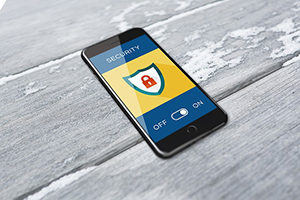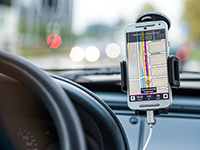National Cybersecurity Awareness Month (NCSAM) occurs annually in October. Started in 2003 by the U.S. Department of Homeland Security and private sector sponsors and nonprofit collaborators that form the National Cyber Security Alliance, this annual event promotes cybersecurity and recommends resources for online safety.  You and your company can make several preparations this month as you look forward to celebrating Cybersecurity Awareness Month with your employees, customers and community.
You and your company can make several preparations this month as you look forward to celebrating Cybersecurity Awareness Month with your employees, customers and community.
Host an Educational Event
Begin planning an open house, expo, lecture, or other educational event that focuses on cybersecurity. Depending on your company, you may decide to focus your educational efforts on information that will benefit senior citizens, college students or families. For example, your IT specialist could present advice that helps consumers avoid cybercrime, or you could show customers how to implement security protocols on their electronic devices. Get creative as you prepare to raise cybersecurity awareness during an educational event.
Train Employees
Cybersecurity training should occur year-round, but your employees may be especially receptive to security tips during a month that’s focused on raising awareness. Take advantage of this annual opportunity to discuss topics like choosing secure passwords, securing electronic devices used for work and managing email safety. Or choose a different topic based on your unique needs.
Focus on Different Weekly Topics
This year, NCSAM includes four weekly topics. In summary, those topics include:
- Online safety at home.
- Training for a cybersecurity career.
- Ensuring online safety at work.
- Safeguarding critical infrastructure throughout the nation.
Your company can prepare to discuss these weekly topics during your events, through customer newsletters and on social media.
Utilize Your Social Media Influence
If your company has a large social media following, you have a powerful platform to raise awareness for cybersecurity. You can write blog posts that outline the importance of cybersecurity, share information about how to join the cybersecurity workforce or detail the ways your business protects data. Also, prepare info-graphs and other visual aids that discuss online safety tips.
Partner with Other Companies
Like NCSAM was started through a collaboration, your company can partner with other businesses as you increase cybersecurity awareness. Share the latest cybersecurity information, create resources that educate the public about cybersecurity or host an online safety seminar together.
Check your Cybersecurity Insurance Coverage
Cybersecurity insurance protects your business in many circumstances. Review your needs with your insurance agent as you ensure you have the correct amount of cybersecurity insurance for your company.
As your business prepares to celebrate National Cybersecurity Awareness Month in October, consider taking these steps now. They give you the tools you need to raise cybersecurity awareness among your employees, customers and community.
Read more
 October, Adopt a Shelter Dog month, is a great time to add a dog to your family. Be careful which breed you adopt, though. Insurance companies use data from insurance claims and public health studies to create a high risk dog breed list, and your homeowners insurance premiums can increase based on the type of dog you adopt. You can save money when you choose a dog that’s not on the high risk list.
October, Adopt a Shelter Dog month, is a great time to add a dog to your family. Be careful which breed you adopt, though. Insurance companies use data from insurance claims and public health studies to create a high risk dog breed list, and your homeowners insurance premiums can increase based on the type of dog you adopt. You can save money when you choose a dog that’s not on the high risk list.
Working Breed Dogs
Agile, powerful and intelligent, Akitas, Alaskan Malamutes, Doberman Pinschers, Rottweilers and Siberian Huskies are also fiercely protective. If they’re not trained properly, these breeds could be potentially dangerous, especially to young children and small pets.
Terrier Breeds
Loyal and protective, American Pitbull Terriers and American Staffordshire Terriers have been bred to hunt. These traits mean they can become aggressive and tenacious if they’re cornered or frightened by one of your family members or guests.
German Shepherds
Police departments, military personnel and ranch hands appreciate this breed because the dogs are intelligent, hard-working and powerful. They’re also suspicious of strangers and won’t back down, which makes them a challenging breed for inexperienced owners to handle.
Chow Chows
Independent and strong Chow Chows are often kept as companions. These fluffy dogs can be aloof and stubborn, though, and should only be adopted by experienced dog owners.
Miscellaneous Breeds
Wolf Hybrid and Presa Canarios dogs exhibit strength and protective characteristics. However, they can also be unpredictable and quick to attack, making them potentially dangerous breeds. Friendly and docile Great Danes are listed on the high risk list, too, because of their size.
A dog adds fun and companionship to your home and family, and adopting a shelter dog is socially responsible. Before you choose a new pet, though, consider whether or not it will increase your homeowners insurance cost. If so, you may choose a different breed or reduce your home insurance premiums by installing a dog fence or raising your deductible.
Read more
 Whether you drive a vehicle that’s hot off the assembly line or one that’s old enough to be an antique, you want your car to last a long time. A fall tune-up helps you achieve your goal. It also maximizes fuel efficiency, prevents expensive repairs and ensures your vehicle runs properly all winter.
Whether you drive a vehicle that’s hot off the assembly line or one that’s old enough to be an antique, you want your car to last a long time. A fall tune-up helps you achieve your goal. It also maximizes fuel efficiency, prevents expensive repairs and ensures your vehicle runs properly all winter.
Read the Owner’s Manual 🙂
In the back of your vehicle’s owner’s manual, you’ll find a tune-up checklist. Follow it carefully as you ensure you repair and inspect all the essential areas of your vehicle this fall.
Fix the Brakes
Your mechanic should inspect the brakes for wear and ensure the brake lights on your vehicle work properly.
Change the Oil
Your vehicle’s engine requires engine oil as it operates smoothly. Top off the oil this fall or invest in a complete oil change, especially if you’ve driven 15,000 miles since your last oil change.
Check the Battery
Wipe off the terminals and make sure the battery is attached correctly. If it’s older than four years, replace it so that you’re not left stranded. Spray some battery protector.
Inspect Hoses
Soft, leaky or loose hoses seem like a small detail, but they’re important for proper engine performance. Inspect all your engine’s hoses to ensure they’re attached properly and replace any that aren’t in good working order.
Top Off Fluids
Low transmission fluid and coolant affect your vehicle’s performance and could damage the engine. Top off these fluids this fall. You’ll also want to fill your windshield washer fluid and the antifreeze reservoir.
Inflate the Tires
You’ll experience a smoother ride and enjoy increased traction when you inflate the tires to the proper level. Find the recommended tire pressure on your vehicle’s door sticker. Tire pressure can reduce slightly in the cold, and your tire pressure sensor (TPS) can sound a false alarm.
Update Insurance 🙂
Now that your car is tuned up, update your auto insurance, too. Make sure you have adequate coverage to handle any repairs or liability that may occur during a winter storm or after an accident. With these tune-up tips, you prolong the life of your vehicle.
Read more

With more people working remotely and spending the entire day looking at computers and phones, they are at risk for eyestrain.
We recommend that they follow these basic precautions.
- Look away from the monitor for 30 seconds, every 15 or 20 minutes. Look at or scan things at least 20 feet away to allow your eyes to focus in a rest position.
- Reposition the monitor 20” to 26” from your eyes (roughly the distance from your eyes to the end of your index finger with arm outstretched). Otherwise, you’ll be forced to sit or lean too close to the screen, or sit too far away. If your eyeglass prescription doesn’t allow clear vision at the 20” to 26” range, get it adjusted.
- Reset monitor height so that the top edge is even with your view when looking straight ahead. Then tilt the screen upward so that you’re not looking at the image at an angle. The optimal screen position is 10 to 20 degrees below eye level.
- Reset the monitor screen resolution, the Internet browser text size, and the zoom and font default in the operating system and in software applications so that text is easy to read. Start with a screen resolution of 800×600 for older CRT monitors and 1024×768 or higher for LCD (flat screen) monitors. Set the monitor refresh rate at or above 75 hertz (Hz) on older CRT models. Refresh rate is irrelevant for LCD monitors and is factory set, usually 60 Hz.
- Blink often (put a sticky note on your monitor!). The average blink rate is 22 times per minute. The rate goes down to seven per minute when looking at a monitor – which causes the eye lens to dry out. If you can’t get into the habit of blinking more often, use an eye moistener (saline solution).
- Relax your eye muscles. Put the palm of your hands over your eyes for a minute or so, once every half hour. This warms the muscles around the eyes, relaxing them.
- Minimize glare. Make sure the background light level around the monitor is about the same as the screen light level. Minimize direct sunlight or bright lights in front of the monitor or directly behind it.
- Adjust the contrast and brightness to levels you use when reading a book comfortably. A bright screen causes eyestrain.
- Use a paper holder to hold documents. Put the document at the same level as the monitor, or attach it to the monitor. This prevents repetitive neck and eye movement from paper to screen.
Read more
 In legal terms, an act of God isn’t, in fact, a religious experience. Well, that’s not to say that an act of God couldn’t be a religious experience, it’s just that that’s not inherent in the legal definition of the term. An act of God essentially comes down to the unforeseen and the unpreventable. You can reduce the likelihood of accidents on the job site by making sure that you don’t allow any drinking, fighting or general carelessness on site, you can reduce the likelihood of accidents on the road through proper auto maintenance, but you can’t prevent a flood or an earthquake no matter how many safety courses you attend.
In legal terms, an act of God isn’t, in fact, a religious experience. Well, that’s not to say that an act of God couldn’t be a religious experience, it’s just that that’s not inherent in the legal definition of the term. An act of God essentially comes down to the unforeseen and the unpreventable. You can reduce the likelihood of accidents on the job site by making sure that you don’t allow any drinking, fighting or general carelessness on site, you can reduce the likelihood of accidents on the road through proper auto maintenance, but you can’t prevent a flood or an earthquake no matter how many safety courses you attend.
Acts of God will exempt a party from strict liability and from negligence in common law. Many building contracts have a provision allowing for acts of God to excuse unexpected delays in a project’s completion. However, damages and delays owing to a natural disaster may be disputed as acts of God in some circumstance.
The key word is “unforeseeable.” If someone falls off of a scaffolding and spends the next four weeks in a cast because of an earthquake, then that will usually be chalked up to an act of God. If they saw a storm coming in, decided to keep working, and then got struck by lightning, then the “act of God” claim may be contested.
“Act of God” is sort of a liability free-pass card, exempting you from responsibility for things that you couldn’t possibly have predicted. There are a few steps that you can take to ensure that there is no gray area, no room for doubt when you need to lean on this legal term:
- Keep tabs on the weather. Don’t assume, for instance, that a storm “isn’t going to be as bad as they say.” It might not be so bad, but do you want to bet your career on it?
- Keep all of your safety equipment in tip top shape. You don’t want to give people any wiggle room to say that that safety harness would have snapped eventually with or without the earthquake.
- This goes for your vehicles, as well. It’s hard to claim a small flood as an “act of God” when your truck was the only one slipping and sliding across the road.
An act of God can be a godsend when it comes to liability, but things have to line up correctly.
Read more
As Americans take to the roadways in record numbers (post pandemic), here are some safety pointers that may be useful to you and your loved ones.
 In your vehicle, it’s easy to feel like you’re secluded from everyone else on the road. Your vehicle is one of many on the road, though. Above all else, you must always prioritize safety and use these etiquette tips.
In your vehicle, it’s easy to feel like you’re secluded from everyone else on the road. Your vehicle is one of many on the road, though. Above all else, you must always prioritize safety and use these etiquette tips.
Obey the Rules of the Road
Every rule of the road applies to you, so obey the speed limit and stop, yield and merge signs. Your agenda is never more important than safety.
Be Considerate
You share the road with other drivers, bikers and walkers, so be considerate. Give other drivers the right of way, let other drivers pass if they’re in a hurry and yield to pedestrians. Don’t demand your own way or give into road rage. Show consideration and make the commute safer for everyone.
Take Turns
When the road narrows from two lanes to one or traffic slows for an accident, take turns merging. It’s better to let someone go in front of you than to cause a pileup.
Turn on Your Headlights
Your vehicle’s headlights allow you to see clearly as you drive at night or in certain types of weather. Remember to turn off your high beams when another car approaches. Also, don’t use your headlights as aggression toward another driver.
Use Your Horn Sparingly
The horn in your vehicle is designed to alert other drivers of dangers. In certain occasions, it’s appropriate to honk your horn, but use it sparingly and remember that laying on the horn is poor manners and a sign of aggression.
It’s appropriate to lightly beep your horn when:
- The light turns green and the driver in front of you is distracted
- It’s the other driver’s turn at the intersection
- Another driver is ready to cut you off because you’re in their blind spot
Do not use your horn to:
- Scold drivers who are speeding or being unsafe in other ways
- Vent your frustrations
Respect Emergency Vehicles
Ambulances, fire trucks and police cars also use the roadways. When you see flashing lights, slow down and pull off to the right side of the road. Wait for the emergency vehicle to pass and then merge back into traffic.
Pull Off the Road if You’re in a Fender Bender
Minor fender benders do occasionally happen. Instead of stopping your vehicle in the middle of the road, pull off the road safely to assess damage and discuss the next step, which may include exchanging insurance information, with the other driver.
Report Emergencies
When you pass a vehicle with its emergency lights on, stop and offer assistance. You can also call 911.
Etiquette goes a long way toward maintaining roadway safety for everyone. Share the road, remain calm and use your manners as you drive safely.
Read more
 You and your company can make several preparations this month as you look forward to celebrating Cybersecurity Awareness Month with your employees, customers and community.
You and your company can make several preparations this month as you look forward to celebrating Cybersecurity Awareness Month with your employees, customers and community.
 October, Adopt a Shelter Dog month, is a great time to add a dog to your family. Be careful which breed you adopt, though. Insurance companies use data from insurance claims and public health studies to create a high risk dog breed list, and your homeowners insurance premiums can increase based on the type of dog you adopt. You can save money when you choose a dog that’s not on the high risk list.
October, Adopt a Shelter Dog month, is a great time to add a dog to your family. Be careful which breed you adopt, though. Insurance companies use data from insurance claims and public health studies to create a high risk dog breed list, and your homeowners insurance premiums can increase based on the type of dog you adopt. You can save money when you choose a dog that’s not on the high risk list. Whether you drive a vehicle that’s hot off the assembly line or one that’s old enough to be an antique, you want your car to last a long time. A fall tune-up helps you achieve your goal. It also maximizes fuel efficiency, prevents expensive repairs and ensures your vehicle runs properly all winter.
Whether you drive a vehicle that’s hot off the assembly line or one that’s old enough to be an antique, you want your car to last a long time. A fall tune-up helps you achieve your goal. It also maximizes fuel efficiency, prevents expensive repairs and ensures your vehicle runs properly all winter.
 In legal terms, an act of God isn’t, in fact, a religious experience. Well, that’s not to say that an act of God couldn’t be a religious experience, it’s just that that’s not inherent in the legal definition of the term. An act of God essentially comes down to the unforeseen and the unpreventable. You can reduce the likelihood of accidents on the job site by making sure that you don’t allow any drinking, fighting or general carelessness on site, you can reduce the likelihood of accidents on the road through proper auto maintenance, but you can’t prevent a flood or an earthquake no matter how many safety courses you attend.
In legal terms, an act of God isn’t, in fact, a religious experience. Well, that’s not to say that an act of God couldn’t be a religious experience, it’s just that that’s not inherent in the legal definition of the term. An act of God essentially comes down to the unforeseen and the unpreventable. You can reduce the likelihood of accidents on the job site by making sure that you don’t allow any drinking, fighting or general carelessness on site, you can reduce the likelihood of accidents on the road through proper auto maintenance, but you can’t prevent a flood or an earthquake no matter how many safety courses you attend. In your vehicle, it’s easy to feel like you’re secluded from everyone else on the road. Your vehicle is one of many on the road, though. Above all else, you must always prioritize safety and use these etiquette tips.
In your vehicle, it’s easy to feel like you’re secluded from everyone else on the road. Your vehicle is one of many on the road, though. Above all else, you must always prioritize safety and use these etiquette tips.